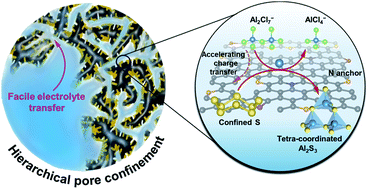Highly reversible aluminium–sulfur batteries obtained through effective sulfur confinement with hierarchical porous carbon†
Abstract
Aluminium–sulfur (Al–S) batteries possess high research merits and application prospects owing to their high theoretical energy density, high safety and low cost. However, the deficiency of outstanding cathodes severely limits their electrochemical performance. Herein, a N-doped hierarchical porous carbon material with a surface area of 2513 m2 g−1 has been developed by a soft-template method. The hierarchical pores can provide effective electrolyte transport channels and stably accommodate S nanoparticles, while the N-doped carbon can facilitate charge transfer and anchor aluminium sulfides to improve the electrochemical stability of the cathode. Coupling the S composite cathode with a low-cost AlCl3/acetamide electrolyte, the Al–S battery can deliver a capacity above 1027 mA h g−1 at 0.2 A g−1 for 50 cycles and an excellent cyclability above 483/405 mA h g−1 at 1 A g−1 for 500/700 cycles. In situ Raman spectroscopy and ex situ solid-state nuclear magnetic resonance have been used to monitor the reversible reactions of S and identify the configuration of sulfides, showing that α-type Al2S3 with a tetra-coordinated configuration is the dominant final discharge product. This work sheds light on the design of S composite cathodes and understanding of reaction mechanisms for the fabrication of high-reversibility, high-capacity and low-cost Al–S batteries.



 Please wait while we load your content...
Please wait while we load your content...